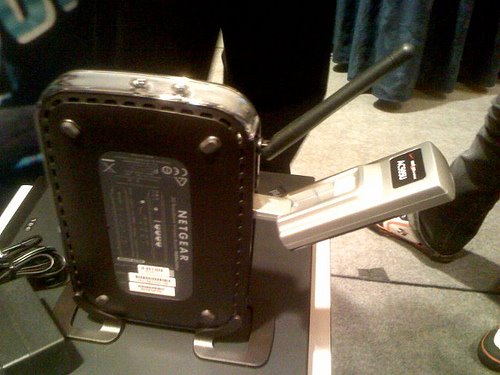This little beauty ties a 3G modem (this one is running on the Verizon network) to a WiFi router. Lots of people can share one mobile data connection, all at the same time. Netgear thinks they’re doing a favor for the mobile phone carriers. Oddly enough, they don’t have relationships with any yet.
The Consumer Electronics Association identified four major trends that will drive the consumer electronics in 2009. Two depend on the wireless data industry to make it happen: mobile devices that provide the same user experience as in-home or in-office gizmos, and devices with embedded Internet capability. (The other two are evolving display and control technology and anything that’s green. Anything.)
In the long run, it’s good news for Clearwire. They see themselves as providing connectivity to the growing ecosystem of wireless-capable gadgets. Unfortunately, the CE guys aren’t thinking of Clearwire. They want to sell millions of units now. That means going with the lowest common denominator: a 3G, or even 2G, data modem. But it’s not such great news for the current mobile phone business model.
From the point of view of a mobile carrier, you plug your wireless data modem into one device, such as your laptop, and that’s it. If you want to use a second device at the same time, you get a second modem, pay for a second data subscription plan and away you go, playing happily inside the walled garden.
The CE industry isn’t thinking along those lines. The very concept of a walled garden is foreign to them: the last thing they want is to have to sell a separate data subscription for every device they sell. They treat the mobile market the same way they treat the fixed data market. You pay for a connection, run it to a router, then load up on the gizmos.
It’s early days yet at CES – the show floor doesn’t even open until tomorrow. But judging from the press conferences and product previews, consumer electronics manufacturers (at least the ones who aren’t already playing in the mobile phone sector) are moving full steam ahead on a couple of assumptions:
- Tethering to a mobile phone’s data connection is every consumer’s right.
- Mobile phone companies should thank (if not pay) them for building devices that allow multiple users with multiple gizmos to share a single mobile data connection.
So far, I haven’t spoken with any CE manufacturers who have a deal with a mobile carrier (again, except for the guys who are already selling phones and modems to carriers) . They plan to push the products into consumers’ hands, and let the market sort things out. We saw a preview of that approach at the CTIA show in San Francisco last year, when TapRoot Systems demonstrated WalkingHotSpot.
Mobile carriers control access to their walled gardens via technology and subscriber contracts. They’ve been able to control the technology so far, because they buy the devices from the manufacturers. But that control will break down as consumers buy their own products and ignore the contracts. Carriers might be faced with a choice: cripple or even eliminate generic data modem service, introduce some kind of packet filtering, or cede control of bandwidth usage to consumers.
Given the rough time that terrestrial ISPs have managing consumer bandwidth usage, I don’t expect mobile carriers to have much success filtering or metering usage. Third party technology providers will work hard to defeat any such efforts. Regulators always keep at least one eye on populist sentiment, and judges are none too enthusiastic about holding ordinary consumers to the impenetrable fine print of terms of service.
Easy, widespread mobile data access is a golden ray of hope in an otherwise dismal outlook for the coming year. It’s an opportunity for CE manufacturers to sell consumers a new version of a gizmo (any gizmo!) they’re already buying, using and loving, by making it mobile. Any manufacturer who is outside the walled garden right now will do whatever it can to break down the walls.
Carriers will fight it. But they’re facing powerful forces: CE manufacturers, content providers (who love the trend), consumers and, likely, regulators.
As Damon Runyon wrote: “the race isn’t always to the swift, nor the battle to the strong, but that’s the way to bet.”

